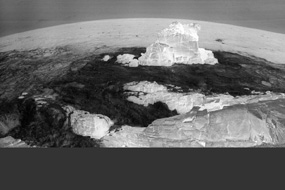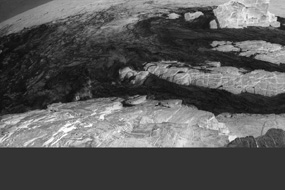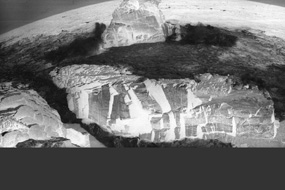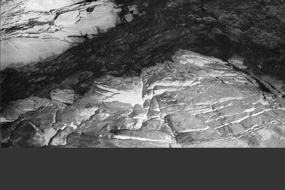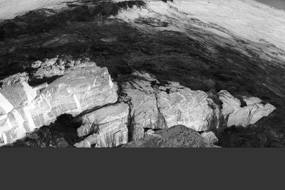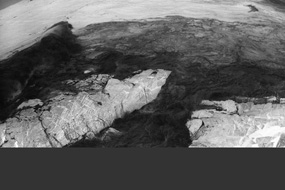Dark Islands, 2013
Photographs I – VI
Inkjetprints on FineArt Baryta, 43 x 83 cm, on Aluminium
The photographs are taken during a severe storm on the westcoast of Quiberon exposed to the open sea. The wind is throwing foamy waves against the rocks, washing over the shapes of the shore and constantly moves the line between sea and land. The original shots are black-and-white negatives. I kept the images inverted in their brightness values in which they reflect the precise opposite of reality.
Another reality is created. The landscape has replaced it's direct recognisability for a transparency and is gaining a strange presence in these special lighting conditions. The rockformations seem to glow from within and remind of icebergs. A specific time of day can’t be assigned, it could be night time.
In a metaphorical sense in these photographs I record a whole world of water and refer to the earth as the blue planet. All I see is water. In a foamy sea I view the rocks as icebergs under a hazy sky.
A single moment of the eternal movement of the sea is frozen in each photograph. The only constant line in a storm would be the horizon line. The curvature of the plane and horizon line, at which we look, creates a distance to the landscape, as if the photographs are taken from a great distance to the earth.
Die Fotografien sind bei starkem Sturm an der dem offenen Meer ausgesetzten Westküste von Quibéron aufgenommen. Das Wasser überspült die Formen der Küste und verschiebt so konstant die Berührungslinie zwischen Wasser und Land.
Die Original-Aufnahmen sind schwarz-weiss Negative. Die Bilder bleiben invertiert. In ihren Helligkeitswerten geben sie das präzise Gegenteil der Realität wieder.
Es entsteht eine neue Realität. Die Landschaft hat ihre Erkennbarkeit durch eine Transparenz eingetauscht und gewinnt eine eigentümliche Präsenz in diesen speziellen Lichtverhältnissen. Die Felsformungen scheinen von innen heraus zu leuchten und erinnern an Gletscher und Eisberge. Eine genaue Tageszeit kann den Bilden nicht zugeordnet werden. Es könnte Nacht sein.
Aus einer ewigen Bewegung ist in jeder Fotografie ein einzelner Moment eingefroren. Die einzige konstante Linie im Sturm ist die Horizontlinie und diese Linie ist in jeder Aufnahme neu beschrieben. Ihre Krümmung erzeugt ein Gefühl von Abstand zur Landschaft, als wären die Aufnahmen aus grosser Entfernung zur Erde gemacht worden.
